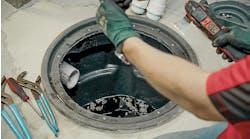If ever there has been a phrase designed to strike fear into our hearts, it has to be this one. If, as has been widely suggested, drain-line carry dictated where adequate drainage stopped and stoppages began forming, we’d be spending every minute of every day occupied with clearing waste blockages. For those of us who are plumbers that have cut into and repaired sanitary sewer lines, we know those drains have a layer of slippery slime that is as slick as a Teflon frying pan! We've also seen clumps of waste left stranded after the water drained and carried itself off to the septic tank or municipal mainline. You’ve often wondered about this "drain-line carry" issue and why you didn’t see more clogged lines. Or, for that matter, why you weren't seeing a plague of clogged house traps.
Enter the use of drain-line video equipment: Everything you ever speculated was happening in drainage lines, but couldn't see, and, therefore, your customers couldn’t see, making it near impossible to convince folks they needed to pay you to dig up their carefully manicured lawns! Those who have invested in high-quality drain-line video-inspection equipment often state, "It's the biggest money maker we ever invested in." If a picture is worth a thousand words — a sewer-line video depicting a belly, break, defect or tree roots is worth thousands of dollars! As it turned out, videos revealed it wasn't at all unusual to encounter left-behind clumps of waste and we were now able to observe what happens during subsequent flushes and drain-line carry. The waste-goo is pushed and/or floated along to eventually exit the building's drain line. It is also apparent that the consistency of human waste changes quite rapidly in this wet environment.
None of the test media (example: bean curd neatly stuffed into condoms) utilized can realistically replicate human waste (those of you who clean drains and unstop stopped-up toilets can assure everyone who does not). Fecal matter is, by itself, hardly anything anyone could claim was consistent and its consistency rapidly changes during the travel from bowl to drain to main (or septic tank)! Anecdotal and interesting tests, to be sure, but only real-world conditions will truly reveal what's to be expected by utilizing high-efficiency toilets.
The only thing that should be introduced into the sewer via toilets is human waste and toilet paper. Not toilet seat covers, feminine hygiene products, wipes, paper towels or any of the dozens of weird objects we plumbers have fished out of toilets and sewer lines, and, therein lies the real issue — toilet and sewer line abuse. If you’re dealing with chronic drain line abuses, install a solution to the unwanted pollution (www.jwce.com).
One other thing our video equipment has revealed: poorly installed sewer lines that incorporate bellies are a major contributor to building clogs. From residential to commercial; from 5-gpf to 1.6-gpf there’s been no apparent increase in the frequency of those clogs. In fact, there seems to be a slight decrease in the frequency of clogs. Time will tell if high-efficiency 1.28-gpf fixtures will create any issues, but the lower the water volume the more critical (I suspect) the need to incorporate proper venting. Although gravity-flush toilets rely on siphonage, improper venting has a dramatic and adverse affect on performance.
Fear is a powerful motivator. Remember the movie Jaws? I saw that while on a beach vacation — big mistake! Even today I hear that music score in my mind when venturing into the ocean. So, who's afraid of upgrading from 1.6-gpf ULF to 1.28-gpf HET? Two ads I’ve seen this past month stand out. One is a DIY center's ad touting $90 annual savings in your water bill by installing a high-efficiency toilet (they’re tugging at the purse strings with "green" labeling). And if 1.28-gpf scares you, you’ll want to stop reading right now. Still with me? Good! Visit www.niagaraconservation.com/niagara_in_the_news.html, and click on World’s First 0.75-gpf Toilet to see the second ad.
According to the folks at WaterSense there are 67 million 5.0-gpf; 33 million 3.5-gpf; and 122 million 1.6-gpf toilets in the U.S. being flushed 6.8 times each day. If all of them were changed to 1.28-gpf HET models tomorrow, we would save more than 361.5 billion gallons of potable-water per year. That’s enough water to provide full flow to both the American and Canadian sides of Niagara Falls for more than five days (www.niagarafallslive.com/Facts_about_Niagara_Falls.htm).
Do I recommend the use of 1.28-gpf HETs for residential, commercial and institutional applications? Absolutely! Will I blame high-efficiency toilets for poor performance and clogged drains? Based on my own experiences to date, and, the past five years using video drain-line inspection equipment, I’ll be looking beyond the toilet bowl for the reasons. As for UHET 0.75-gpf? Bring it.
Dave Yates owns F.W. Behler, a contracting company in York, Pa. He can be reached by phone at 717/843-4920 or by e-mail at [email protected].
All Dave Yates material in print and on Contractor's Web site is protected by Copyright 2009. Any reuse of this material (print or electronic) must first have the expressed written permission of Dave Yates and Contractor magazine. Please contact via email at: [email protected].

